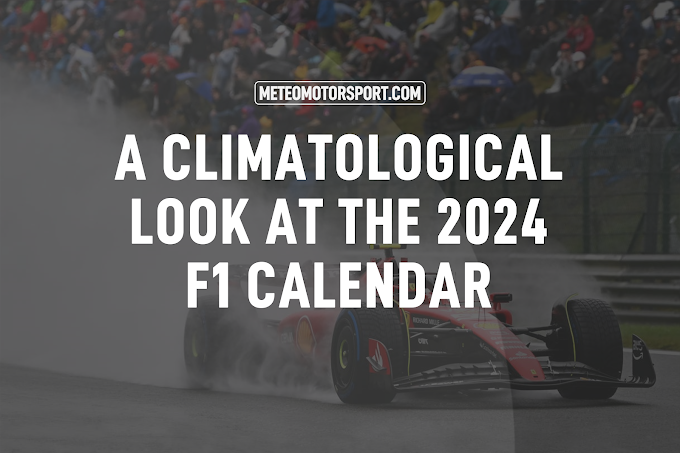The 2025 Formula 1 calendar retains all of last year’s races for a record-equalling 24-round season. While most races retain their relative positions on the calendar, there are a few noticeable changes this year primarily due to Ramadan, each with varying impacts on the expected weather conditions during the race weekend.
MeteoMotorsport has analysed the climatology of each race venue on its scheduled race day in 2025 to see what weather conditions are statistically most likely at each Grand Prix this season and has compiled a list of five key things to look out for this season.
Temperature

With Saudi Arabia moving to late April, it claims the title of the hottest race of the season based on climatological average daily temperature data, slightly ahead of Singapore and Bahrain. Despite this, all three events, held in the evening under floodlights, are expected to see air temperatures in the mid-to-high-20s when the five lights go out.
Miami is statistically likely to be the warmest daytime race, with its mid-afternoon start time in South Florida in early May likely to produce afternoon highs of around 29°C. Meanwhile, the Hungarian, Italian, Azerbaijan, U.S., Qatar, and Abu Dhabi Grand Prix are climatologically projected to experience temperatures in the mid-to-high-20s.
China’s shift to late March (see details in the “Five Things to Watch” section below) positions it as the coldest race of the year, with average daytime maximum temperatures of just 14°C. The late-night race on the streets of Las Vegas in late November is statistically the third coldest of the year, although temperatures at its first two races (17–18°C at 22:00 local time) were notably warmer than average.
Precipitation

Austria and Brazil maintain their status as the events most likely to observe precipitation, with a 46% and 45% risk of rain on race day, respectively. Singapore closely follows with a 42% risk, while Montreal has a 38% risk.
Wet weather tyres are unlikely to be necessary at the Middle Eastern races in Bahrain, Saudi Arabia, Qatar, or Abu Dhabi, although pre-season testing in Bahrain in late February saw localised showers. Likewise, the desert climate in Las Vegas in late November yields just a 5% risk of rainfall.
Wind

Zandvoort, a coastal seaside resort on the North Sea, is climatologically the windiest race of the season, with an average wind speed of 20.4 km/hr. Baku, also know as the City of the Winds, is ranked second, with an average wind speed of 19.7 km/hr. Races in Shanghai, Miami, and Silverstone round out the top five windiest races.
At the other end of the scale, the climatologically calmest races of the year include the Austrian Grand Prix in the Austrian Alps, the Italian Grand Prix at Monza, and the Brazilian Grand Prix at Interlagos, although the latter comes with the risk of gusty winds from thunderstorms.
Five Things to Watch
1. China Moves To March: Cold
Chinese Grand Prix, Shanghai, 21–23 March 2025
With the shift of the Bahrain and Saudi Arabian Grand Prix to April due to Ramadan, the race in Shanghai picks up a late March slot for 2025 as the second round of the championship.
It will be the earliest in the calendar year that the race has taken place, having previously occupied a September or October slot between its inaugural race in 2004 and 2008, and an April slot between 2009 and 2019, as well as on its return to the calendar last year.
The 2025 race is a month earlier than 2024 (23 March compared to 21 April) and this is reflected in cooler conditions expected for this year’s event. On 23 March, the average daytime temperature in Shanghai is around 14°C, which contrasts with the climatological high of 21°C in late April—last year’s race saw near-climatological temperatures of 18–19°C during the race.
The shift to late March also sees a slight increase in the climatological risk of precipitation—from 29% to 33%—and one of the meteorologically windiest races of the season with an average wind speed of 18.1 km/hr.
The earliest in the year the race has been run is 9 April (2017), which saw cool temperatures of 12–13°C and a race that started damp/wet and cloudy and was incident strewn throughout. Could we see similar conditions in 2025?
2. Bahrain Moves To Mid April: Warmer
Bahrain Grand Prix, Sakhir, 11–13 April 2025
With the holy month of Ramadan occurring throughout March this year, the Bahrain Grand Prix moves back six weeks from a season-opening slot in early March to mid April for 2025. This won’t be the first time the race has run at this time of year, but it will be the first time it will have run in April since 2017.
Average daytime temperatures on 13 April are around 30°C, roughly 7°C warmer compared to 2 March (when the 2024 race occurred). The race has run under floodlights since 2014 and early evening temperatures on 13 April are climatologically around 21–23 °C, around 4–6°C warmer than on 2 March.
3. Saudi Arabia Moves to Late April: Warmer
Saudi Arabian Grand Prix, Jeddah, 18–20 April 2025
Like Bahrain (see above), the Saudi Arabian Grand Prix is pushed back six weeks to avoid Ramadan. This will be the first time the race has run in April, having previously taken place in December (2021) and March (2022–24).
Running later in the year climatologically results in higher daytime and overnight temperatures. On 20 April, daily maximum temperatures in Jeddah average 34°C, with overnight lows of 23°C, which are both around 4°C warmer than on 9 March when the 2024 event ran. The race runs under floodlights with a start time of 20:00 local time; temperatures at this time of day on 20 April average around 28°C, a few degrees warmer than the same time of day on 9 March.
There is no change to the climatological risk of precipitation between early March and late April at just 1%.
4. Spain Moved to early June: Marginally Cooler
Spanish Grand Prix, Catalunya, 30 May–1 June 2025
The Spanish Grand Prix has moved around in recent years between a date in early May (2021), late May (2022), early June (2023), and late June (2024). This year it returns to an early June date the week following the Monaco Grand Prix.
Climatologically, the average daytime maximum temperature on 1 June in Montmeló is 23°C; this is a few degrees lower than the 26°C of 23 June, when the race ran in 2024.
5. The 2026 Calendar
Announced sometime during the Spring?
While not strictly related to 2025, we are eagerly awaiting confirmation of the 2026 calendar. Formula 1 aims to rationalise and regionalise the calendar to make it more environmentally sustainable. The shake-up could significantly change the expected weather on some race weekends.
We already know the Canadian Grand Prix will move from its traditional mid June slot and will take place on the third or fourth weekend of May each year. This will pair it (potentially back-to-back) with Miami and remove a transatlantic crossing from Europe to North America. This calendar move is likely to result in a cooler race weekend in Montreal, and potentially a higher risk of rain.
It has been reported that the inaugural Madrid Grand Prix on the IFEMA street is slated for 6 September. The weather in the Spanish capital in early September usually consists of clear skies, highs of 24–32°C, and a low risk of rain.
We also know the Monaco Grand Prix will move back one week and run on the first weekend of June each year, in a move to accommodate the Canadian Grand Prix moving to May and to consolidate the European season. There is only a marginal change in expected weather conditions with a one week shift.
Those in the know have speculated that Bahrain and Saudi Arabia will return to hosting the opening two races of the season in late March (Ramadan ends on 18 March 2026), with Australia moving back to early April, to be followed by Japan and China in late April and early May, with Miami and Canada following in the middle of May, followed by the European season kicking off in Monaco on 7 June 2026. Whether there will be major changes elsewhere through the calendar remains to be seen.
2025’s calendar was released in April 2024, so it may be released in the coming months. We will have a full breakdown as soon as the calendar is out, so stay tuned!
Climatology But Not A Forecast
This climatological analysis represents the average weather conditions over the last 30 years on the scheduled race date and does not represent a specific forecast for 2025. Real-time weather forecasts are based on an ensemble of numerical weather prediction models, which incorporate observations of air pressure, temperature, humidity, winds, and many other variables to produce the best estimate of current and future conditions in the atmosphere at a range of time horizons.
This analysis uses climatological data of the scheduled race date of the nearest available weather station to each race venue. Note that the climatological average daily temperature represents the average of the climatological daily minimum and climatological daily maximum temperatures. While most Grand Prix take place in the mid-afternoon and therefore coincide with typically the hottest part of the day, this is not always the case, especially for those races that take place at night. The stated climatological risk of precipitation is representative of the risk across the entire 24-hour period of the day (00:00 to 23:59) of the scheduled race date and therefore may not be representative of the approximate two-hour window of the race time.
For the latest Formula 1 weather forecast, visit the dedicated MeteoMotorsport F1 Weather Centre, which provides an overview of the current weather conditions, the latest six-day forecast, and real-time satellite and radar imagery of the circuit, and follow MeteoMotorsport on X.







